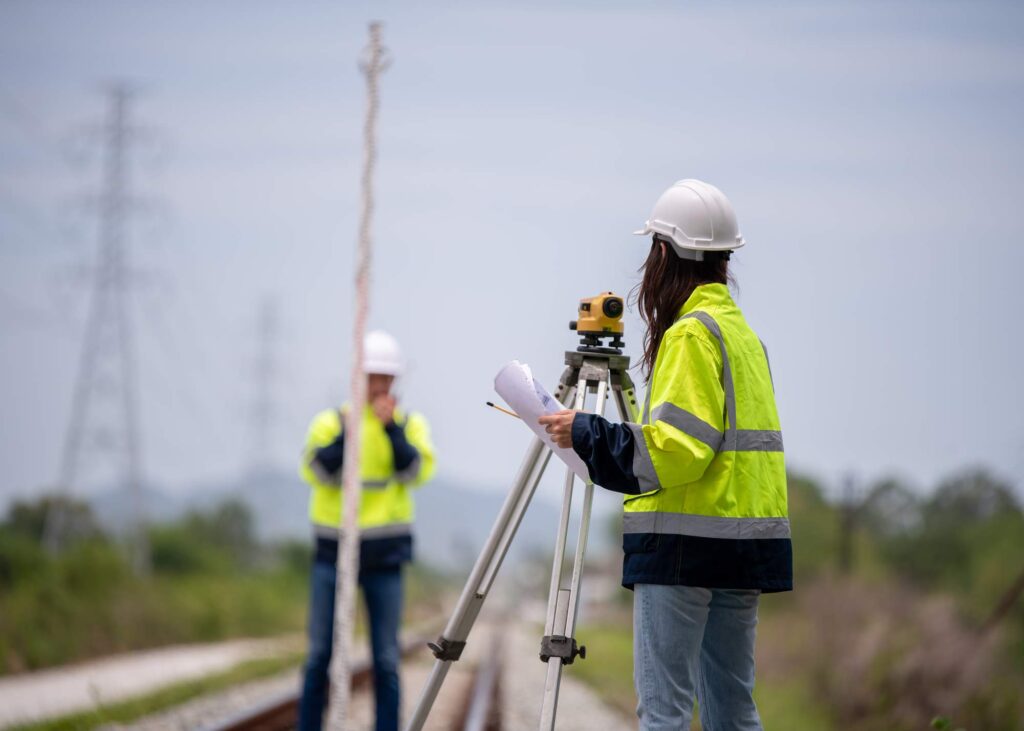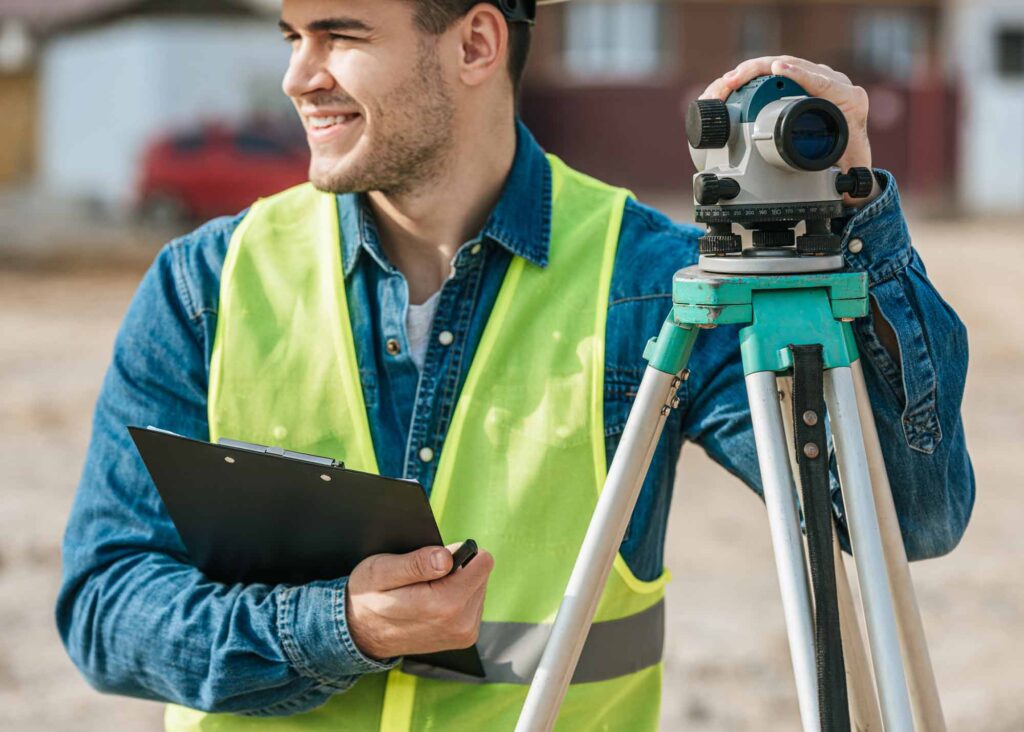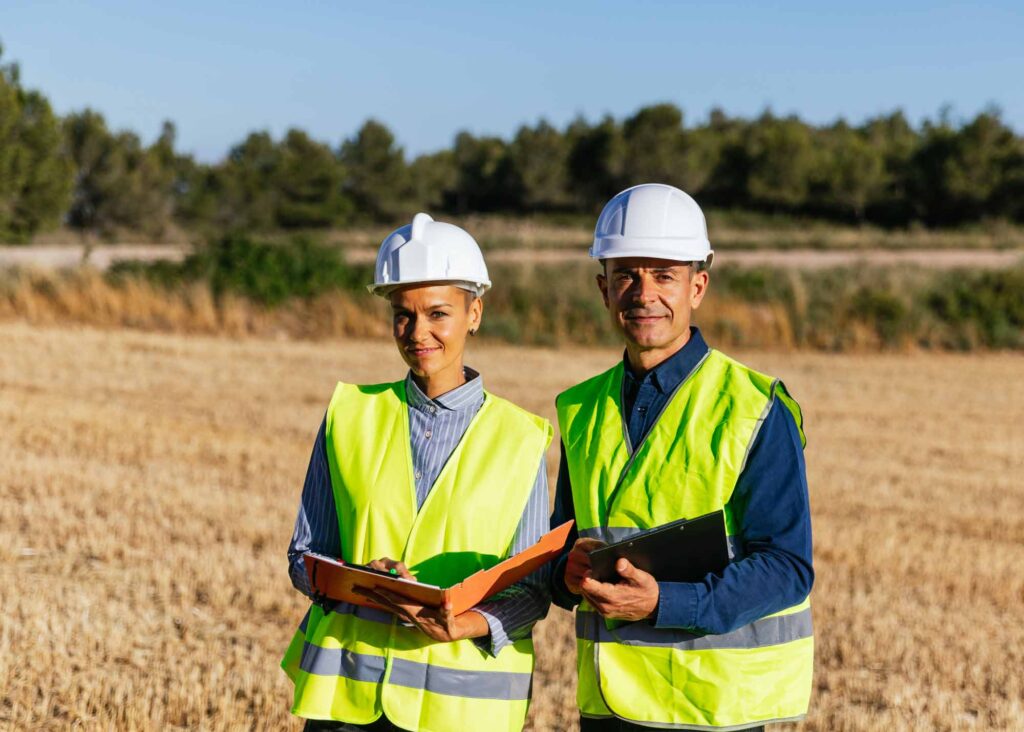When planning a real estate transaction or construction project, your ability to obtain precise and accurate information about the landscape or parcel of land is of utmost importance. You’ll need a professional land surveyor to identify these key metrics and map your land, but knowing what type of land survey you need can be confusing.
Read on to determine the type of land survey that might work best for your needs, and also to learn about other, more specialized types of land surveys that have unique use cases in Colorful Colorado.
In this article we will cover:
- Hydrogeological and Hydrographic Surveys
- Geodetic and GIS Surveys
- Boundary Surveys
- Location Surveys
- ALTA/NSPS Land Title Surveys
- Construction Surveys
- Site Planning Surveys
- Subdivision Surveys

Hydrogeological and Hydrographic Surveys
Both hydrogeological and hydrographic surveys relate to gathering information in and about bodies of water. A hydrogeological survey assesses groundwater resources by mapping aquifers, analyzing water quality, and determining the possibilities for groundwater extraction and management. A hydrographic survey measures and describes features which impact maritime navigation, marine construction, and offshore industries like wind farms, drilling, and dredging. This includes the study and mapping of physical features of submerged land areas, underwater terrain, depths, and structures. These surveys can provide critical information to water engineers when working on water management solutions for a property or construction site.
Application of Hydrographic and Underwater Surveys in Colorado
The Colorado River and its tributaries are responsible for providing water to seven U.S. states and two states in Mexico; therefore water management continues to be an issue of critical importance in Colorado and surrounding states. In 2019, the Colorado Water Conservation Board (CWCB) released the Analysis and Technical Update to the Water Plan to provide a thorough picture of the supply and demand of water in the state of Colorado. Part of this work included the completion of hydrographic and hydrogeological surveys. Associated with this work, the Colorado Geological Survey, a state government agency operated within the Colorado School of Mines, has helped to ensure the information remains publicly accessible in an easily-accessible digital format through their Colorado Groundwater Atlas.

Geodetic and GIS Surveys
Geodetic Surveys
When the size and scope of a land survey is small, the Earth can be considered to be flat for practical purposes. In these small-scale cases, a plane survey may be appropriate to determine the position of permanent points on the Earth’s surface. However, when greater size and specificity is required, a geodetic survey will provide the highest degree of precise accuracy. A geodetic survey is a large-scale measurement which factors in the angle of the Earth’s curvature while calculating angles, bearings, distances, and elevation or levels of terrain. Geodetic surveys provide widely spaced control points on the earth’s surface for subsequent, smaller plane surveys.
Geographic Information Systems (GIS) Surveys
Geodetic surveys provide a framework that supports GIS data, which includes digital data of parcel and utility information for land surveyors, property owners, governments, and entities concerned with urban planning and infrastructure development, among other things. One of the most important modern applications of data derived from geodetic and GIS surveys is their use in Global Positioning System (GPS) and other Global Navigation Satellite Systems (GNSS).
Application of Geodetic and GIS Surveys in Colorado
Because geodetic and GIS surveys provide a high amount of precision and detail at a large scale, which can then be applied at smaller scales, their use cases are nearly endless, both in the surveying industry and any other industry which needs information about the land upon which we live. This scalability makes them the perfect tool to use in the Rocky Mountains of Colorado, where the elevation changes of peaks, plains, and mesas add complexity to the work of completing an accurate survey at a smaller scale. One example of a use case for a large-scale geodetic survey is the Colorado Aggregate Resources Map, which was created by the Colorado Geological Survey to collect information on Colorado rock and mineral deposits for land use planning and resource development.
Boundary Surveys
Also known as land survey plats (LSPs), a boundary survey is used to measure and depict the precise and exact corners and limits of a particular parcel of land. The most common use cases for these types of surveys are within real-estate transactions to assess the size and shape of a plot of land before purchase; to plan the construction of property-defining assets; to make improvements on existing structures; to create easements or encroachments; or to resolve disputes, such as party responsibility for property damage.
Application of Boundary Surveys in Colorado
Boundary surveys and land survey plats are the most commonly requested and used types of surveys based on their wide applicability in many industries. One specific example of the importance of boundary surveys in Colorado is in the instance where damage is caused by fallen branches or trees during one of Colorado’s famous winter snow storms. In these cases, the determination of property lines (and thus fiscal responsibility) becomes essential.
Location Surveys
More general than a boundary survey, a location survey is also commonly used in the process of buying property or constructing a new feature on existing property. Rather than marking the specific boundaries of the property, a location survey is used to mark the location of changes or improvements on the property in relation to the approximate boundary lines. This information is used for zoning inquiries, building permits, or corrections to tax assessments. The boundary lines in a location survey are approximated within a few feet, plus or minus, and within those lines, the boundary survey reveals features like lakes, streams, rivers, water wells; plus overlapping use areas, like easements or encroachments. Improvement Location Certificates (ILCs) are a specific type of location survey known to be fast and cost-effective, but their imprecision makes them impractical in resolving disputes. If more precise information is needed about the location of a particular improvement to the exact boundary line, customers might request an Improvement Survey Plat (ISP), which combines both the precise data from a boundary survey and the improvement locations from a location survey into a visual map or plat.
Application of Location Surveys in Colorado
The geology of the world is ever-changing due to movement of tectonic plates, erosion, and mining; and Colorado’s landscape contains all of these factors that influence the size and shape of the land. Additionally, Colorado has seen a 7.4% population growth over the last decade, causing a thriving real estate market, investments in infrastructure development, and fluctuating property values. With so much natural and human-created change, land surveys are incredibly useful to determine the accurate current location of physical aspects of land, rather than relying on historical data. Additionally, savvy Colorado homeowners would be wise to consider a location survey to ensure their property taxes are assessed according to accurate, real-time data.

ALTA/NSPS Land Title Surveys
Similar to a boundary survey, but with much more detail, a land title survey is used to gather information about a piece of land for the purpose and need of title disputes and title insurance matters in land sales. Specifically, the land title survey is designed to uncover information which might not otherwise be included in the public record in order to create a clear understanding of the properties of the associated land between the insured, the client, the title insurance company, the lender, and the surveyor. The client requesting the survey is responsible for ensuring the adequate permissions for the surveyor to access the property, neighboring properties, or easements.
Importance of Land Title Surveys
Title insurance in Colorado protects the legal ownership of a property when it is purchased. When someone buys a property, they acquire not only the physical structure of the but also the ownership history, which includes all previous transactions and claims on the property. Going beyond a physical boundary survey, a land title survey investigates potential ownership issues, like unresolved liens, unpaid taxes, errors in public records, or even undisclosed heirs who claim ownership rights. By obtaining a land title survey and title insurance in Colorado, the buyer ensures that the property history has been thoroughly investigated and issues resolved before the property changes hands..
Choosing an ALTA/NSPS Land Title Survey vs Generic
Attorneys Title Insurance of Aspen emphasizes that title insurance shields homeowners from unexpected hidden risk that may arise from the property’s past ownership history, and the gold standard for land title surveys are ALTA/NSPS surveys, which has strict measurement standards and documentation conventions for records research, fieldwork, monuments, rights of way and access, lines of possession and improvements along the land boundary, buildings, easements and servitudes, cemeteries, and water features. ALTA/NSPS also requires the creation of a plat or map that visually depicts the above information. The Minimum Standard Detail Requirements for ALTA/NSPS Land Title Surveys can be found here, and features can be added to the ALTA survey under negotiation of the surveyor, client, insured, and insurer.
Application of ALTA/NSPS Land Title Survey in Colorado
The state of Colorado is home to both stunning natural vistas and dynamic urban areas. These celebrated features have increased the desirability of land in Colorado, which can generate the grounds for potential disputes over land ownership. Some of the most common reasons for title disputes in Colorado include boundary and survey disputes, liens, errors in public records, undisclosed heirs, and fraud and forgery; therefore a surveyor helping to prepare an ALTA/NSPS survey in Colorado is providing the valuable work of protecting a homeowner’s peace of mind.
Other Surveys Used in Site Planning, Design, Construction, and Real Estate
Construction Surveys
An essential part of any construction project, a construction survey measures and maps the precise position and layout of a plot of land for the purpose of building new roads and structures. Completed after the planning and design phase, a construction survey stakes out the location of walls, buildings, roads, and utilities on the property; and provides updated topographical measurements for vertical and horizontal grading. This information is then used to position construction equipment, adhere to design plans and zoning requirements, and more.
Site Planning Surveys
Typically the first survey requested at the onset of a construction project, a site planning survey is used in the initial planning and design process to determine the feasibility of a particular project at the proposed location. Before evaluating feasibility, scope, and budget, contractors must have accurate data on existing structures, utilities, roadways, access points, topography, vegetation and wetlands, soil conditions, and flood zones (as determined by FEMA Federal Flood Insurance Reference Maps). Project managers use the information from the site planning surveys and construction surveys to draft the tangible action steps for completing the project.
Subdivision Surveys
A subdivision or partition survey divides an existing piece of land into smaller parcels by creating new boundary lines. This type of survey creates new lots, tracts, or estates, which can make land easier to sell or develop. The process includes an initial assessment, field survey, and the final survey product. Subdividing a piece of land into contained elements has tax, construction, and land ownership implications; therefore completed subdivision surveys must generally be recorded with the appropriate local and state government agency.
Application of Site Planning, Construction, and Subdivision Surveys in Colorado
In a joint collaboration between Comcast Media and Technology Center and the University of Denver, the 2022 Impact Report highlights the enormous impacts of the construction industry on the State of Colorado, which includes new development, renovations, roadwork, demolition, and general contracting. In 2020, the state held 14,800 various construction jobs, creating a $23.5 billion contribution to the state’s annual Gross Domestic Product (GDP). This data reveals that construction is the eighth most valuable industry in the state of Colorado, making all three of the above surveys essential skills in the toolkit of any Colorado Land Surveyor.
Guide to Colorado Surveying
Colorado boasts dynamic cultural institutions and a diverse population with a near-universal love of the outdoors, underpinned by the state’s unique landscape and access to vital natural resources. These conditions have created steady population growth, job security, and a roaring real estate market. With so many desirable features, understanding the physical terrain upon which we live has important repercussions. Land surveying continues to play a key role in providing accurate data and maps for all of the above use cases. For those of you interested in even more information about land surveying, check out the blog at Roaring Fork Engineering.

